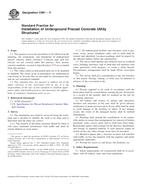Potrebujeme váš súhlas na využitie jednotlivých dát, aby sa vám okrem iného mohli ukazovať informácie týkajúce sa vašich záujmov. Súhlas udelíte kliknutím na tlačidlo „OK“.
ASTM C1723-10
Standard Guide for Examination of Hardened Concrete Using Scanning Electron Microscopy
Automaticky preložený názov:
Štandardné Príručka testov zatvrdnutého betónu Použitie Snímacie elektrónové mikroskopie
NORMA vydaná dňa 1.10.2010
Informácie o norme:
Označenie normy: ASTM C1723-10
Poznámka: NEPLATNÁ
Dátum vydania normy: 1.10.2010
Kód tovaru: NS-12305
Počet strán: 9
Približná hmotnosť: 27 g (0.06 libier)
Krajina: Americká technická norma
Kategória: Technické normy ASTM
Kategórie - podobné normy:
Anotácia textu normy ASTM C1723-10 :
Keywords:
analysis of concrete, EDX, energy-dispersive X-ray spectroscopy, microanalysis, microscopy, petrography, photomicrographs, scanning electron spectroscopy,, ICS Number Code 91.100.30 (Concrete and concrete products)
Doplňujúce informácie
| 1. Scope | ||||||||||||
|
1.1 This guide provides information for the examination of hardened concrete using scanning electron microscopy (SEM) combined with energy-dispersive X-ray spectroscopy (EDX). Since the 1960s, SEM has been used for the examination of concrete and has proved to be an insightful tool for the microstructural analysis of concrete and its components. There are no standardized procedures for the SEM analysis of concrete. SEM supplements techniques of light microscopy, which are described in Practice C856, and, when applicable, techniques described in Practice C856 should be consulted for SEM analysis. For further study, see the bibliography at the end of this guide. This guide is intended to provide a general introduction to the application of SEM/EDS analytical techniques for the examination and analysis of concrete. It is meant to be useful to engineers and scientists who want to study concrete and who are familiar with, but not expert in, the operation and application of SEM/EDS technology. The guide is not intended to provide explicit instructions concerning the operation of this technology or interpretation of information obtained through SEM/EDS. It is critical that petrographer or operator or both be familiar with the SEM/EDX equipment, specimen preparation procedures, and the use of other appropriate procedures for this purpose. This guide does not discuss data interpretation. Proper data interpretation is best done by individuals knowledgeable about the significance and limitations of SEM/EDX and the materials being evaluated. 1.2 The SEM provides images that can range in scale from a low magnification (for example, 15×) to a high magnification (for example, 50 000× or greater) of concrete specimens such as fragments, polished surfaces, or powders. These images can provide information indicating compositional or topographical variations in the observed specimen. The EDX system can be used to qualitatively or quantitatively determine the elemental composition of very small volumes intersecting the surface of the observed specimen (for example, 1-10 cubic microns) and those measured compositional determinations can be correlated with specific features observed in the SEM image. See Note 1. Note 1—An electronic document consisting of electron micrographs and EDX spectra illustrating the materials, reaction products, and phenomena discussed below is available at http://netfiles.uiuc.edu/dlange/www/CML/index.html. 1.3 Performance of SEM and EDX analyses on hardened concrete specimens can, in some cases, present unique challenges not normally encountered with other materials analyzed using the same techniques. 1.4 This guide can be used to assist a concrete petrographer in performing or interpreting SEM and EDX analyses in a manner that maximizes the usefulness of these techniques in conducting petrographic examinations of concrete and other cementitious materials, such as mortar and stucco. For a more in-depth, comprehensive tutorial on scanning electron microscopy or the petrographic examination of concrete and concrete-related materials, the reader is directed to the additional publications referenced in the bibliography section of this guide. 1.5 Units—The values stated in SI units are to be regarded as standard. No other units of measurement are included in this standard. 1.6 This standard does not purport to address all of the safety concerns, if any, associated with the use of electron microscopes, X-ray spectrometers, chemicals, and equipment used to prepare samples for electron microscopy. It is the responsibility of the user of this standard to establish appropriate safety and health practices and determine the applicability of regulatory limitations prior to use. |
||||||||||||
| 2. Referenced Documents | ||||||||||||
|
Podobné normy:
Historická
1.12.2013
Historická
1.12.2013
Historická
15.1.2013
Historická
1.1.2011
Historická
1.2.2014
Historická
1.12.2013
Odporúčame:
Aktualizácia technických noriem
Chcete mať istotu, že používate len platné technické normy?
Ponúkame Vám riešenie, ktoré Vám zaistí mesačný prehľad o aktuálnosti noriem, ktoré používate.
Chcete vedieť viac informácií ? Pozrite sa na túto stránku.



 ASTM C881/C881M-13..
ASTM C881/C881M-13.. ASTM C882/C882M-13a..
ASTM C882/C882M-13a.. ASTM C890-13
ASTM C890-13 ASTM C891-11
ASTM C891-11 ASTM C90-14
ASTM C90-14 ASTM C900-13a
ASTM C900-13a
 Cookies
Cookies
